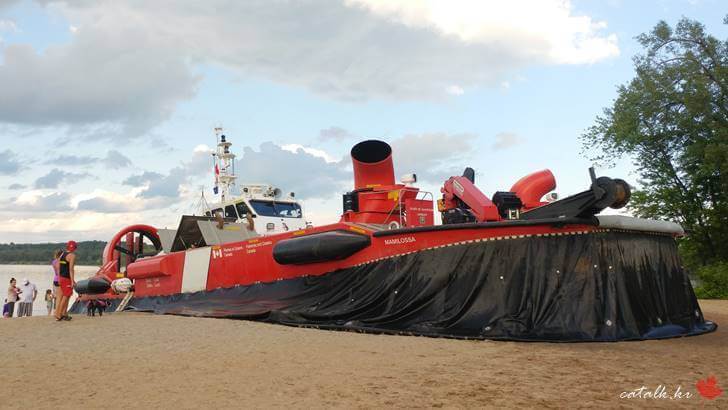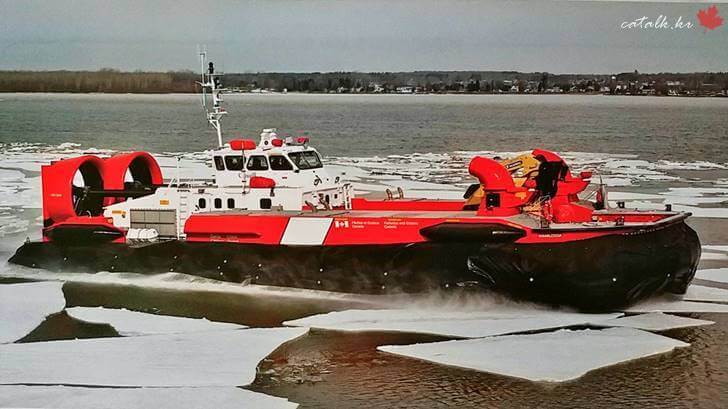CCGS Mamilossa, Hovercraft of Canadian Coast Guard
The Hovercraft of Canadian Coast Guard
When I took a walk at the Petrie Island beach, Ottawa, I found the hovercraft. It moved with big sound and waves on the river and then docked on the waterfront. It is the CCGS Mamilossa AP1-88/400 hovercraft. She is based in Trois-Rivières and like all other Canadian Coast Guard units, it can be deployed rapidly to any area in Qubec region.

what is a Hovercraft?
Hovercraft, the product name of British Hovercraft, which was first developed in the UK, is used as the type of ship. A ship makes air cushion by blowing compressed air strongly from the lower surface to the water surface, supporting the weight, and floating up slightly from the water surface. It is also called an air cushion vehicle(ACV).
the History of the Hovercraft
Christopher Cokerel (1910-1999) designed the first commercially available hovercraft SRN1(Saunders Roe Nautical One). He envisioned a hovercraft in 1953, but by June 1956 he had produced a three-person hovercraft capable of traveling 29 miles an hour. Cocherrell decided to blow air into the narrow tunnel around the hovercraft. The air that entered the narrow tunnels escaped to the center, and during this process, a high-pressure cushion that supported the weight of the hovercraft could be formed and floated on the ground.
Today, a commercial hovercraft can cross the English Channel in 30 minutes. The army uses hovercrafts for soldiers and weapons transport, while oil companies are delivering excavating equipment to inaccessible areas. Also, it can be used to move wetlands, reeds and swamps without damaging aquatic organisms.
CCGS Mamilossa of Canadian Coast Guard Hoverwork Hovercraft

The CCGS Mamilossa – pronounced ma-mi-lo-ssa – word in the Abenaki language that means “it walks from the shore onto the water”, is a heavy and powerful amphibious hovercraft that will be used to clear ice jams from rivers and areas that are hard to rach with coventional icebreakers. It plays an essential role in preventing floods in eastern Canada. She is the largest hovercraft exported by British shipbuilders.
Due to its versatility, the CCGS Mamilossa is used as a buoytender, meaning that she can be called on to lay, service and recover buoys and support navigation aid construction and maintenance operations.
This hovercraft is equipped with a removable crane capable of lifting up to 6,600 kg. Her versatility and 23,000 kg payload enable her to transport any combination of cargo and paseengers. Vehicles can be loaded directly on deck via a bow ramp. This last caracteristic makes the Mamilossa particularly effective on environmental response.
Specifications of CCGS Mamilossa
- Type: Air Cushion Vehicle(ACV)
- Length: 28.5 m
- Width: 12 m
- Power: 3281 kW
- Maximum speed: 50 knots(92.6km/h)
- Cruising speed: 45 knots(83.34km/h)
- Maximum weight: 75 tm
- Crew: 8
- Builder: Hoverworks Limited, Isle of Wight, England
- Construcion completed: 2009
- In service: 2009-present
- Homeport: CCG Hovercraft Base Trois-Rivières – Quebec Region



